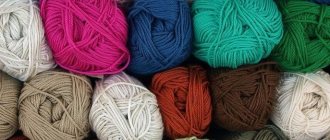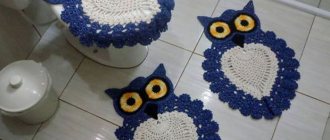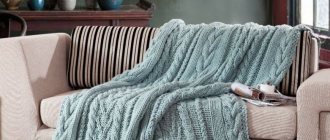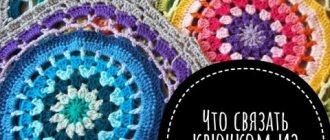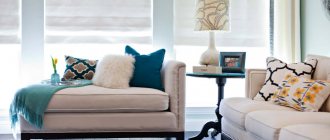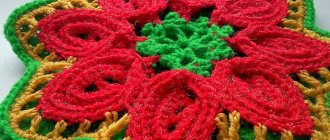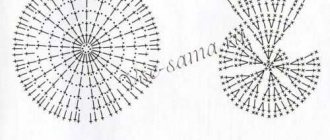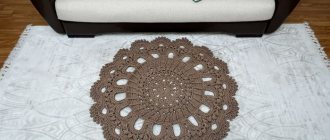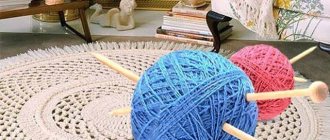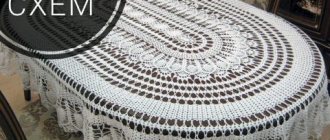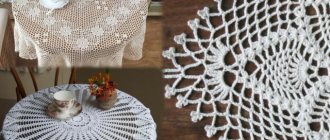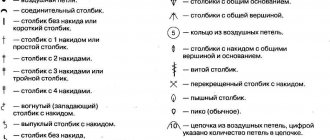There are threads made from mixed fibers: natural and synthetic. Products made from such materials are durable and hold their shape well.
Choosing a hook for knitting curtains
In order for the finished product to turn out smooth and beautiful, it is important to choose the right knitting tool. For thick and dense thread, select a hook with a large diameter corresponding to the yarn. For a thin thread, use a small-diameter hook or knitting needles.
Hooks come in plastic (for thick wool or acrylic threads) and metal (for thin natural fibers).
Color selection
When choosing the color of future curtains, you need to focus on your own taste and the interior of your home, the size of the window and the room in which the curtains will be located.
Curtains made of white and light threads are suitable for small rooms with small windows. Visually expand the space, create a feeling of freshness and cleanliness. Suitable for both strict classical style and touching rustic or romantic.
In a rustic style, muted natural shades of blue, green and lilac are appropriate.
Contrasting curtains of bright colors should match the interior items and harmonize with it, so as not to attract unnecessary attention and be appropriate in the room.
Patterns
There are many different patterns to choose from, so it's easy to choose one that you like and matches the style of your home. And a self-invented ornament will turn your curtain into a designer art object.
You can choose a repeating pattern. This is a simple and easy to implement option. Suitable for any interior. Build entire storylines with pictures of nature (for example, for a rustic style), experiment with color. Curtains look beautiful when assembled from different motifs into a single whole. Sweet cats, butterflies, and angels will add coziness to your home environment.
If you want the curtain to let in a lot of light, choose a pattern with large spaces between the main elements. Add fringe to short curtains.
How to calculate the amount of yarn
It's not very pleasant when the threads run out at the most inopportune moment. Therefore, before starting work, be sure to calculate the amount of yarn for your hand-knitted product.
To do this, you need:
- knit a sample - a fragment of the main pattern (this can be a square with sides of 10 cm);
- wash, dry and iron the sample;
- unravel to measure the length of the thread that went into making it;
- measure the window or doorway to determine the size of the curtain;
- calculate the amount of yarn using the data obtained.
When calculating yarn, you need to keep in mind that yarn made from natural fibers loses 5 to 10% of its weight after washing.
Natural materials
Cotton threads of the “iris” type are distinguished by smooth fibers; when crocheting, they do not tangle or curl. This cotton material is dyed in all shades of 7 basic colors. The advantage of these threads is that they do not discolor or fade over time, although they are made of pure cotton.
Linen threads are also 100% natural, but rough and subdued in color. To obtain a richer shade, polyester synthetic fibers are added to them. Linen products have a pronounced texture and are practically impossible to smooth out.
The properties are similar to linen bamboo fibers, but they do not wrinkle and can be ironed perfectly.
Wool threads are distinguished by their elastic strength, which do not wrinkle and stretch well.
Silk threads are distinguished by a full-color palette. Their peculiarity is that, depending on the lighting, the already saturated shades can shimmer with all the colors of the rainbow. They are durable and very durable.
Silk and cotton threads are considered the most suitable for hand-crocheting miniature curtains for the bedroom (or kitchen). If the goal is to knit a large thick curtain, then you need to choose bulky linen or wool threads.
Hook selection
In order for a knitted product to be beautiful and the loops to be even, in addition to the skill of the needlewoman, a normal tool is required, i.e. Crochet hook. Dense and thick threads require a large hook, the diameter of which corresponds to the thickness of the yarn. Thin threads are knitted with small hooks or knitting needles. For woolen threads, choose hooks made of plastic, for thin threads - metal ones.
Knitted lambrequins
This textile element in the design of the window opening is the logical conclusion of the stylistic solution. A knitted lambrequin harmoniously combines with wicker curtains, as well as with curtains and curtains made from traditional materials: tulle, organza, cotton, linen, etc. When combining different materials, an interesting design technique would be to play with the fabric texture and color combination:
- On dense monochromatic curtains made of natural fabrics, a weightless air-knit lambrequin looks original. It will resemble a weightless cobweb through which the main fabric of the curtain shines through.
- Or vice versa, knitted from thick threads, a bright lambrequin will give a mischievous and touching look to a boring white curtain.
You can knit a lambrequin with crochet or knitting in several ways. By changing the top knitted patterns, you will add completely new color or stylistic accents and mood to the same curtain.
Choosing curtain designs for different rooms
Each room has its own meaning. Therefore, the curtains for each of them should not be the same as in other rooms. Another important aspect is the direction of the window, because... The illumination of the room depends on the direction of the world. For southern windows you need to knit long (completely covering the window sashes) and dense fabrics that disperse the sun's rays well. For dimly lit rooms, you can opt for loose knitting patterns and choose short curtain models.
For kitchens and other non-residential rooms
The kitchen is the most functional place in the home and requires the most practical curtains. Any surface in the kitchen can serve as a work surface, including the window sill. Consequently, curtains are required here not for the entire window, but covering only part of it. Such small items are easy to crochet.
Since the curtain will be washed often, you need to select the strongest possible yarn and patterns with the highest knitting density, then the appearance of the curtain will last longer. When crocheting, the bottom edge of the curtain does not have to be straight; it is better to make it in the shape of flowers or leaves. You can also crochet a fringe, a rounded or wavy edge.
For the bedroom
In the bedroom, long floor-length curtains, decorated with a complex patterned composition, look best. French motifs are appropriate in the bedroom or when the canvas is decorated with tassels or fringe and slightly gathered. When the curtains are long, it is better to make them in the form of two panels, separated in the middle of the window, so that access to the balcony or to the window itself is provided.
In this case, canvases are allowed in different colors, and their number is more than two. The traditional option looks good when the light curtains are in the center and closer to the window, and the dark ones are on the sides, on top of the light ones.
For children's
In the children's room, there are organic curtains with fairy-tale motifs: animals, trees, cartoon characters. Preferably the so-called fillet crochet. This means that the pattern is knitted in a tight pattern (single crochet), as a result, the children's room can do without thick night curtains.
for Valentine's Day.
For Valentine's Day, you can make fillet patterns in the shape of a heart. It can be placed in a frame against a background of bright fabric. Or sew it to a pillow. Or process the edges of such a fillet heart with a crochet lace crochet to make a napkin for the table . These knitted valentine napkins can be given to friends. This is a gift that is easy and quick to crochet with your own hands.
How to crochet curtains using ready-made patterns
Check out the DIY curtain models shared by our needlewomen. In any case, along the upper edge of the fabric there is an empty section of fillet knitting, through which the curtain rod passes, from which the curtain is hung. Below this section, the pattern itself is made according to the diagram.
We offer several models of the most successful knitting. Our great-grandmothers often crocheted small curtains for the kitchen; today such needlework is becoming fashionable again. There are many crochet curtain patterns available, take any one. Even a novice needlewoman can knit a beautiful curtain for a country house or a rural mansion. You just need to find a nice pattern, threads, a hook and free time for creativity.
Knit according to the pattern
To correctly tie the curtains according to the proposed pattern, you first need to study it. Photos in sources are often accompanied by a detailed diagram. Simple patterns that any needlewoman can understand, are explained in detail by the attached photographs, and at each stage of knitting loops there is a description of the required actions.
Having understood several ways to knit chains of loops and stitches, any needlewoman will be able to crochet the most complex pattern according to the pattern, as well as come up with her own designs and patterns. Next, we offer several interesting “curtain” schemes
patterns.
Drunk butterflies
Crocheted according to the author's pattern called “drunk butterflies”. For some reason, the author of the idea called the pattern “drunk”; she was probably collecting locks from beer cans. The author also classified her creation as blinds, although it is closer to thread curtains, or muslin.
The essence of the idea is that each jar key is crocheted in the form of two butterfly wings. The two keys are connected into one, resulting in a design that looks like a butterfly. For the curtain, depending on its size, you will have to stock up on a large number of keys. They are tied with columns with different numbers of crochets.
When several of these butterflies are prepared, they can be connected with one vertical thread. These threads are sewn at one end to a horizontal braid, which is attached to the cornice. Such a curtain looks extravagant, but it does not move along the cornice, i.e. This is a decorative element that can be assembled using tiebacks.
Knitted kitchen curtain with pattern
Openwork curtains can be crocheted using several techniques. Let's list the common ones:
- Bruges lace is an imitation of ancient needlework made from rounded patterns.
- Irish lace is a mesh of connected parts knitted separately.
- Fillet lace - alternating loose mesh and dense sections according to the type of appliqué. This is how flowers, birds, still lifes and entire landscapes are knitted.
- Brumstick (so-called Peruvian lace) is an openwork fabric consisting of repeating motifs.
- Romanian lace - lace weaving is done along the canvas.
How to crochet curtains using ready-made patterns
For curtain knitting, choose natural threads with some added synthetics, then the finished fabric will keep its shape and retain its attractiveness without deforming after numerous washes. To work, it is enough to know only how air loops are crocheted and indicated on the diagrams, as well as stitches of 4 types: single crochet, 1, 2, 3 crochets. Once you master these 5 basic crochet elements, you can master any crochet idea.
Curtains "Lace flowers" with scalloped edge
To work you will need:
- Threads (100% cotton, 380 m by 50 g), 350 g;
- Hook No. 1-1.25;
- White sewing threads;
- White cambric – 1.7 m.
Knitting is carried out using the fillet technique with a density of 14.5*14.5 cells or 10*10 cm. Border size: 60*15 cm.
Description of work:
The work begins with the formation of the outer scallops separately, rows from 14 to 74 are knitted across the entire width of the curtain and finished with scallops. For one festoon you need to knit a chain of 29 chains. p. and 4 v. p. for lifting, then knit according to the pattern up to the 12th row, including it. This way you need to knit only 7 festoons.
In the 13th row, all scallops need to be connected, making 3 stitches between them. p. The diagram shows only 5 elements, the rest are knitted in exactly the same way. The final ornament should look symmetrical.
After 74 rows you need to finish the festoons, each separately. Cut out the cambric, trim its edges and sew the border to the curtain.
Knitting pattern for curtains “Lace flowers”
Kitchen curtain according to the “Village house” pattern
A curtain with a village street, bathed in bright sunshine, will protect the room from prying eyes. Strips of hearts are knitted between the rows of houses, which adds tenderness to the curtain. This type of crocheting with patterns only seems complicated, but in reality it will bring nothing but pleasure.
Scheme of curtains “sun”
This curtain is crocheted in the “loin knitting” style. It scatters direct sunlight well and has a positive psychological effect. You won't buy anything like this in a store. The lovely sunshine on the entire window will improve your mood every time you look at your curtain. This is a simple interior decoration with a powerful positive psychological effect. Fillet knitting, dense in places, will gently diffuse bright sunlight and make the room much more comfortable.
Various room styles
The fillet knitting technique (alternating empty and filled cells) is not suitable for all rooms. Despite the fact that it allows you to knit a fabric with absolutely any pattern (even a novice knitter can create a pattern on his own), the curtain will have a pronounced stylistic orientation - rustic style. That is, curtains using this technique are suitable for a romantic kitchen, country house, or cottage. An excellent option would be a curtain with fillet stitch as a curtain between two rooms, picked up with clips or holders.
It is possible to give this curtain a modern look by combining it with another type of knitting, using empty squares and airy patterns.
The muslin curtain, which consists of vertically hanging knitted threads on a window or doorway, is now very popular. Large wooden beads are used to make the canvas heavier and give it an ethnic feel. It is not recommended to choose plastic ones, as they make a fairly loud sound in the event of a collision.
The exception is muslin with plastic beads tied around it.
Curtains in the macrame style are very heavy and dense, because strong and rigid threads are used to weave the product. However, they have a great advantage - under their weight they hang evenly, the pattern never gets lost, and if accidentally touched, they quickly return to their original position. But, as a rule, macrame weaving on windows is suitable for rooms in Country and Safari styles, and it is hung only on the upper part of the window (to its middle) as a decoration.
Multi-colored crocheted curtain with pattern
Colored curtains, due to their diversity, are able to divert the eye from the flaws of the renovation and interior, because... are a bright accent. By choosing a combination of colors to suit your psychotype, you can create extraordinary comfort and a unique atmosphere in the room, which will work better than a psychotherapist. Bright multi-colored curtains of 3 or more colors radiate the euphoria of the holiday.
To knit them, you can use the remains of different threads. You can knit colorful curtains using different techniques; we offer our ideas with diagrams and descriptions.
Air curtain made of floral motifs
This very light airy openwork curtain is knitted from simple motifs - flowers. True, I didn’t look at the diagram carefully and knitted a flower with 12 petals instead of 16.
Similar to the first option, you first need to knit large motifs, and then small ones. The connection is made using two arches.
Please note: in the video in the 3rd row I knit two columns into arches, but you need three.
Curtains for the kitchen 7 crochet patterns
We offer 7 of the most interesting patterns for crocheting curtains for the kitchen:
- Openwork simplicity.
- Peacock close up.
- Friendly sunshine.
- In Garden style.
- Openwork motifs.
- Curtain border.
